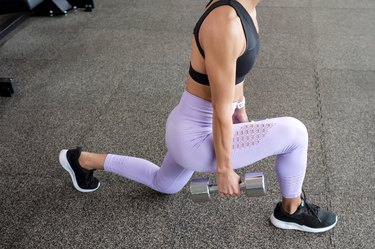
When you work out, your muscles do their job by pulling on your bones, which function as levers to create movement. Levers can be classified as either first, second or third class, according to Kinesiology of the Musculoskeletal System: Foundations for Rehabilitation.
Most exercises use third-class levers, which are the most common in the body, but a few employ first- and second-class levers.
Video of the Day
Video of the Day
What Is a Lever?
A lever is a rigid structure, such as a bar or bone, that rotates around an axis, termed the fulcrum. In your body, muscles supply the force to move your bones, which rotate around fulcrums located at your joints.
The weight your muscle has to overcome — whether that of a limb, your whole body or an external weight such as a barbell or dumbbell — is termed the "resistive force," or simply the "resistance." Levers are classified according to the relative placement of the fulcrum, resistance and force.
First-Class Lever Examples
In a first-class lever, the fulcrum is located between the resistance and the force. A seesaw is a first-class lever. First-class levers in the body are rare, and few exercises utilize them.
Examples, however, are exercises that require elbow extension, such as dumbbell triceps extensions, cable triceps push-downs and triceps dips. In each of these exercises, the elbow joint serves as the fulcrum, which lies between the resistance and the force applied by the triceps muscle behind the elbow.
For the triceps dips, you can use a bench at the gym or your own staircase. Sit on the bench and place your hands beside your hips with your fingers hang over the side, says ACE Fitness. With either outstretched legs or bent knees and your feet flat on the floor, lift your hips off the surface and use the strength of your arms to lower down. Hold. Rise back up and repeat 10 times.
Read more: Physical Benefits of Dips Exercises
Second-Class Levers
Second-class lever examples in the body are also fairly rare. In a second-class lever, the resistance lies between the fulcrum and the force, as in a wheelbarrow. Exercises that require plantarflexing the ankle, such as seated or standing calf raises, employ a second-class lever.
In a calf raise, the resistance — the weight of the body — is positioned between the fulcrum at the toes and balls of the feet, and the force, which is applied by the calf muscles pulling on the heel. Push-ups also utilize a second-class lever.
A calf raise is performed by balancing on your toes on a surface higher than the floor. Lower your heels and then rise up onto your toes. Hold onto a bar or the wall, says ExRx.net, to keep your balance.
Third-Class Levers
ExRx.net notes that most levers in the body are third-class levers, in which force is applied between the fulcrum and the resistance. A shovel is an example. Biceps curls employ a third-class lever, with the force being exerted by the bicep muscle between the fulcrum at the elbow joint and the weight in your hands.
Other examples include seated and lying hamstring curls, seated leg extensions, dumbbell flies, and shoulder dumbbell front and lateral raises.
For the lateral raise, hold a dumbbell in each hand with your palms facing toward your hips. Exhale and raise the dumbbells out to the side until they reach shoulder height. Inhale and lower your arms.